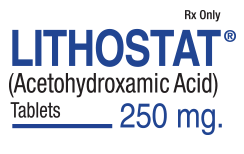Clinical Information
Lithostat® (Acetohydroxamic Acid) Tablets with Antibiotic Therapy May Reduce the Risk of Recurrence of Infection Stones1
- Potent urease inhibitor2
- Effectively inhibits struvite stone growth2
- Effectively lowers ammonia and pH levels2,3
- Provides another treatment option after postsurgical monotherapy with antibiotics2
Struvite Stones
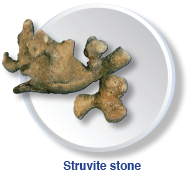
Struvite stones, also known as infection stones, are most common in people who are susceptible to urinary tract infections (UTIs). The most common bacterial organism that leads to infection stones is Proteus mirabilis; however, other bacteria can also be involved.4
Who’s at risk for struvite stones?5
- Spinal cord injury (SCI) patients, at risk for both infection and metabolic stones
- Elderly
- People with diabetes
- Premature infants
- Infants with congenital urinary tract malformation
- Patients with urinary stasis as a result of urinary tract obstruction, urinary diversion or neurologic disorders
Struvite Stone Pathogenesis5
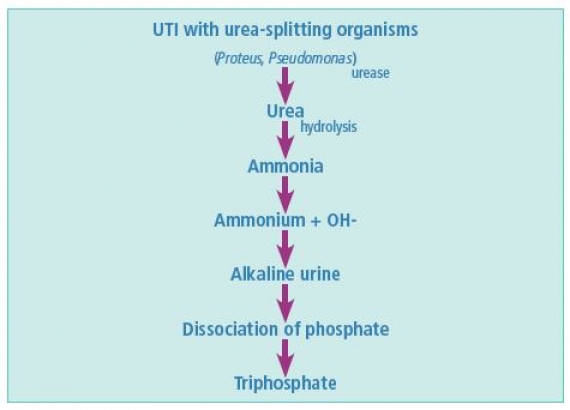
Lithostat as Adjunctive Therapy
A potent urease inhibitor2,3
- Lithostat (acetohydroxamic acid), also called AHA, is indicated as an adjunct to antimicrobial therapy in patients with chronic urea-splitting urinary infection3
- Decreases urinary ammonia and alkalinity in order to enhance the effectiveness of antimicrobial agents and allow an increased cure rate of infection stones3
- Facilitates successful antibiotic treatment of urea-splitting Proteus infections after surgical removal of infection stones not cured by three months of antibiotic monotherapy3
- Reduces the risk of stone growth in patients who were not candidates for surgical removal of struvite stones2
Proven in clinical trials to reduce the risk of recurrent infection stones2,3
- AHA retards growth of and/or partially dissolves existing crystals or calculi implicated in struvite stone growth3
- Long-term treatment with AHA may be warranted to maintain urease inhibition as long as urea-splitting infection is present2
Proven Effectiveness
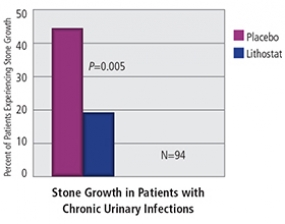
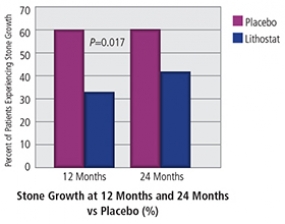
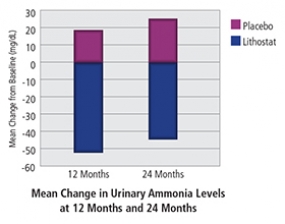
Lithostat Dosing Guidelines3
- Oral dosing
- Adults:
- 1 tablet TID or QID
- Total daily dose up to 10 mg/kg/d to 15 mg/kg/d
- The recommended starting dose is 12 mg/kg/day. The maximum daily dose should not exceed 1.5 grams, regardless of body weight
- Children:
- Detailed studies involving dosage in children have not been established
- Children have tolerated a dose of 10 mg/kg/day, taken in two or three divided doses, for up to one year. Close monitoring of such patients is mandatory
Lithostat is not for use in place of curative surgical treatment, nor is it a replacement for appropriate antimicrobial treatment. Lithostat is not for patients with infections caused by nonurease-producing organisms.
CONTRAINDICATIONS: Lithostat should not be used in female patients who do not evidence a satisfactory method of contraception or are pregnant.
INDICATIONS: Lithostat (Acetohydroxamic Acid) is indicated as adjunctive therapy in patients with chronic urea-splitting urinary infection. Long-term treatment with AHA may be warranted to maintain urease inhibition as long as urea-splitting infection is present.
References:
- Griffith DP, Gleeson MJ, Lee H, et al. Eur Urol. 1991;20:243-247.
- Griffith DP, Moscowitz PA, Carlton CE. J Urol. 1979;121:711-715.
- Lithostat [package insert]. San Antonio, TX: Mission Pharmacal.
- Griffith DP. Kidney International. 1978;13:372-382.
- Pearle MS, Lotan Y. Urinary Lithiasis: Etiology, Epidemiology, and Pathogenesis. In: Wein AJ, Kavoussi LR, Novick AC, et al. Campbell-Walsh Urology. 9th ed. Philadelphia, PA: W.B. Saunders Company; 2007.
- Griffith DP, Khonsari F, Skurnick JH, et al. J Urol. 1988;140:318-324.

